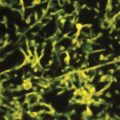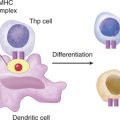CASE 16
DF is a 25-year-old woman, pregnant for the third time. She is known to have blood group A, Rh negative (Rh−) red cells. Her husband is also type A but Rh positive (Rh+). Their first-born child, a boy, was healthy but during the second pregnancy DF was noted to have an indirect Coombs’ titer of 1:32 in her serum. This fetus was followed closely, and a healthy baby girl was induced (vaginal delivery) at 36 weeks of gestation. DF received RhoGam after this delivery. It is now 3 years later and DF is pregnant again. You are monitoring her indirect Coombs’ antibody titer and find it to be 1:32 at 12 weeks and 1:48 at 18 weeks. Amniotic fluid was obtained beginning at 22 weeks of gestation and every 2 weeks thereafter. The amniotic fluid was shown to have increasing amounts of bilirubin (a pigment derived from a breakdown of heme), suggesting hemolysis of fetal red cells. At 28 weeks of gestation, a blood sample obtained from the umbilical vein revealed a hematocrit of 6.2% (normal 45%), confirming profound anemia in the fetus.
QUESTIONS FOR GROUP DISCUSSION
RECOMMENDED APPROACH
Implications/Analysis of Laboratory Investigation
Direct Coombs’ Test
The direct Coombs’ test is used to detect the presence of maternal anti-Rh IgG antibodies that have bound to the fetal red blood cells (see Case 15). The subsequent addition of anti-Fcγ antibodies, generated in another species, manifests in agglutination when (maternal) IgG antibodies are bound to the fetal red blood cells. This test is used when testing newborns for the presence of maternal IgG antibodies bound directly to the Rh antigen on their red blood cells.
Indirect Coombs’ Test
In contrast, in the indirect Coombs’ test we are testing for the presence of circulating anti-Rh IgG antibodies in serum (see Case 15). Therefore, an additional step is required. Red blood cells may be obtained from any source, the criteria (in this case) being that they express the Rh antigen. The mother’s serum is then allowed to react with these (allo or xeno) red blood cells, which will bind anti-Rh antibodies (if) present in the mother’s serum. Thereafter, the test is the same as that described for the direct Coombs’ test. Anti-IgG antibodies are added and the sample is considered positive for anti-Rh antibodies if agglutination manifests (see Case 15).
THERAPY
Because the fetus was profoundly anemic, 85 mL of type O, Rh− packed red blood cells were transfused into the umbilical vein. At 31 weeks of gestation another sample of blood was obtained from the umbilical vein and tests indicated that the hematocrit was only 19%, indicating that the fetus’s red blood cells were still being destroyed. The fetus was transfused with an additional 65 mL of type O, Rh− packed red blood cells. At 34 weeks of gestation the hematocrit of a blood sample from the umbilical vein was 22%, resulting in an order for a further 70 mL of type O Rh− packed red blood cells to be transfused into the umbilical vein. At 35 weeks of gestation all measures indicated that the fetus was sufficiently mature (especially pulmonary/cardiac) to sustain extrauterine life without difficulty. Accordingly, labor was induced and a normal female child was delivered. The hematocrit in the umbilical vein blood at this time was 30%. The infant did well thereafter, and no further therapeutic measures were necessary.
HEMOLYTIC DISEASE OF THE FETUS
Effect of IgM Anti-Rh Antibodies on a Coombs’ test
Consider a scenario in which the serum of an Rh− woman, who is pregnant, gives a negative indirect Coombs’ test but agglutinates Rh+ cells suspended in saline. The most likely explanation for this phenomenon is that she has IgM anti-Rh antibodies that, being pentameric, are very effective in agglutinating Rh+ cells in saline, unlike IgG anti-Rh antibodies. However, because IgM antibodies do not cross the placenta they are unlikely to cause a problem with the pregnancy. It would be wise to monitor her anti-Rh antibodies to ensure she does not (later) develop a positive indirect Coombs’ test, signifying the presence of IgG antibodies.






